Taxation Law of Australia Individual Assignment - Term 1 2019
VerifiedAdded on 2023/03/17
|19
|4240
|68
Homework Assignment
AI Summary
This document provides a comprehensive solution to a Taxation Law of Australia assignment. The assignment covers various aspects of Australian taxation law, addressing questions on topics such as the effective life of assets for depreciation, tax offsets, top tax rates, capital gains tax (CGT) exemptions, CGT events, and the formula for income tax calculation. The solution further explores allowable deductions, including interest on borrowings, and discusses the deductibility of expenses related to work, child care, theft, and job seeking. Moreover, the assignment delves into CGT events, long-term leases, the use of land by new owners, partial exemptions for property used for income and residence, and the implications of capital gains and losses from share transactions. The solution provides detailed answers, references relevant legislation, and includes case law to support its arguments, offering a thorough analysis of the tax law principles.
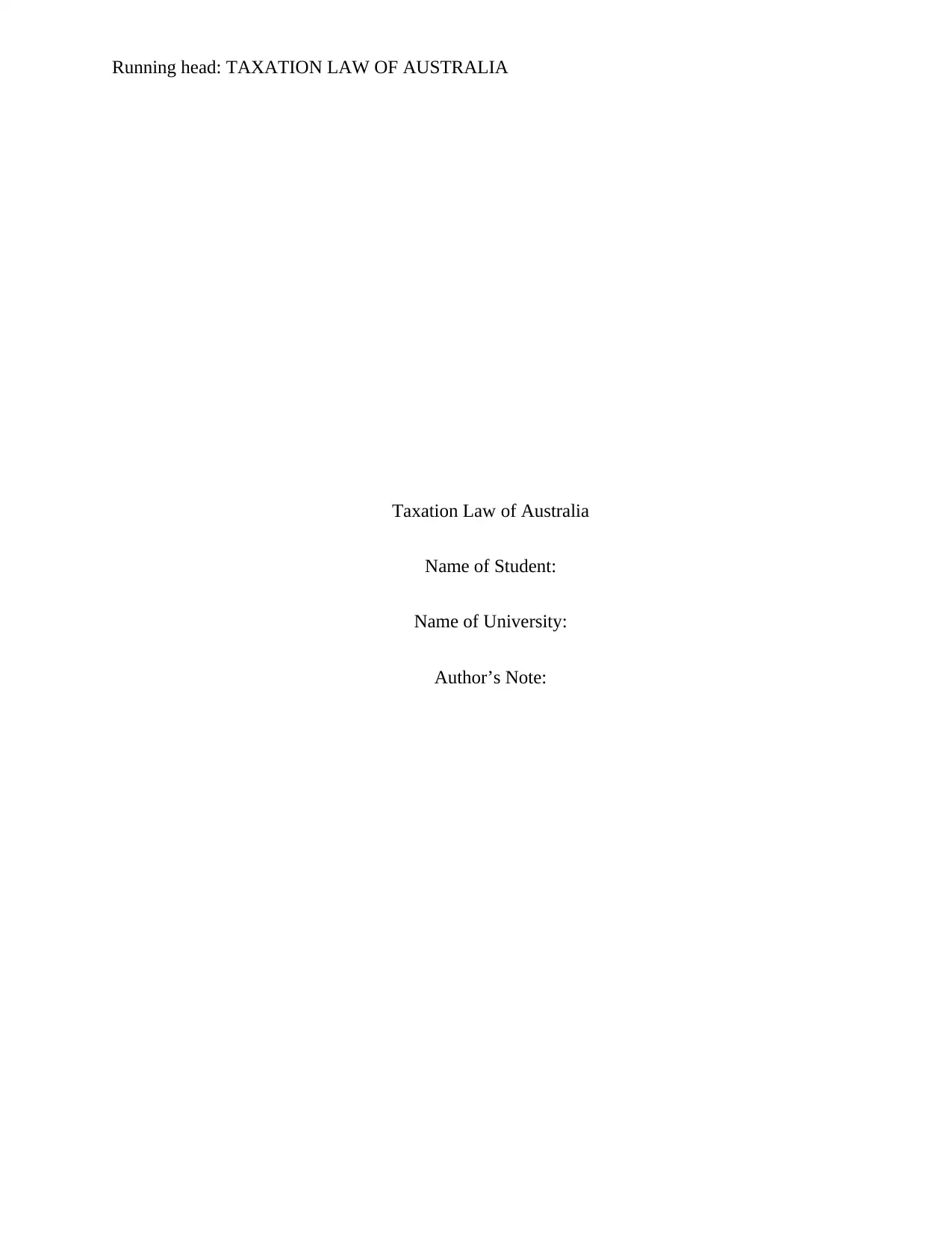
Running head: TAXATION LAW OF AUSTRALIA
Taxation Law of Australia
Name of Student:
Name of University:
Author’s Note:
Taxation Law of Australia
Name of Student:
Name of University:
Author’s Note:
Paraphrase This Document
Need a fresh take? Get an instant paraphrase of this document with our AI Paraphraser
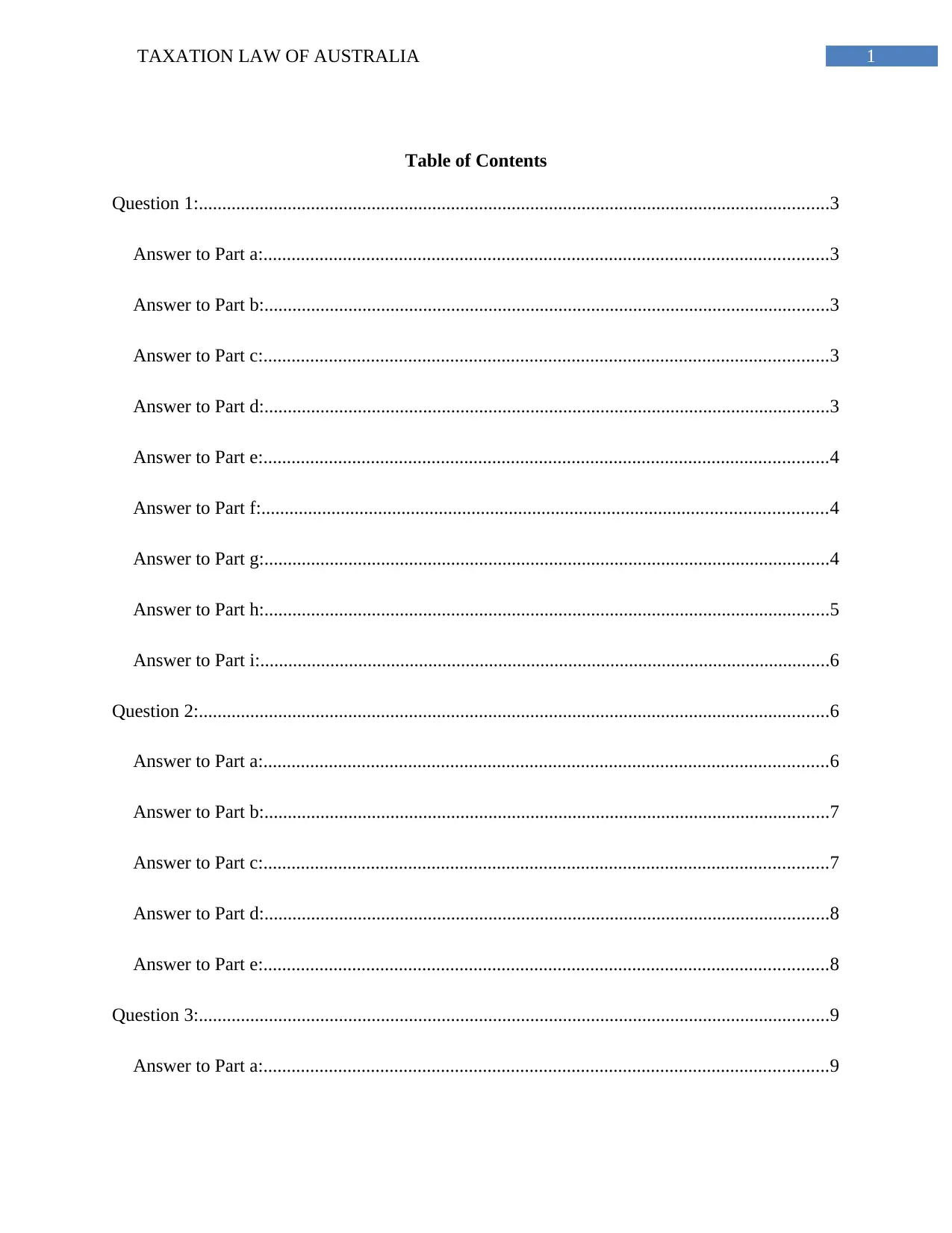
1TAXATION LAW OF AUSTRALIA
Table of Contents
Question 1:.......................................................................................................................................3
Answer to Part a:.........................................................................................................................3
Answer to Part b:.........................................................................................................................3
Answer to Part c:.........................................................................................................................3
Answer to Part d:.........................................................................................................................3
Answer to Part e:.........................................................................................................................4
Answer to Part f:.........................................................................................................................4
Answer to Part g:.........................................................................................................................4
Answer to Part h:.........................................................................................................................5
Answer to Part i:..........................................................................................................................6
Question 2:.......................................................................................................................................6
Answer to Part a:.........................................................................................................................6
Answer to Part b:.........................................................................................................................7
Answer to Part c:.........................................................................................................................7
Answer to Part d:.........................................................................................................................8
Answer to Part e:.........................................................................................................................8
Question 3:.......................................................................................................................................9
Answer to Part a:.........................................................................................................................9
Table of Contents
Question 1:.......................................................................................................................................3
Answer to Part a:.........................................................................................................................3
Answer to Part b:.........................................................................................................................3
Answer to Part c:.........................................................................................................................3
Answer to Part d:.........................................................................................................................3
Answer to Part e:.........................................................................................................................4
Answer to Part f:.........................................................................................................................4
Answer to Part g:.........................................................................................................................4
Answer to Part h:.........................................................................................................................5
Answer to Part i:..........................................................................................................................6
Question 2:.......................................................................................................................................6
Answer to Part a:.........................................................................................................................6
Answer to Part b:.........................................................................................................................7
Answer to Part c:.........................................................................................................................7
Answer to Part d:.........................................................................................................................8
Answer to Part e:.........................................................................................................................8
Question 3:.......................................................................................................................................9
Answer to Part a:.........................................................................................................................9
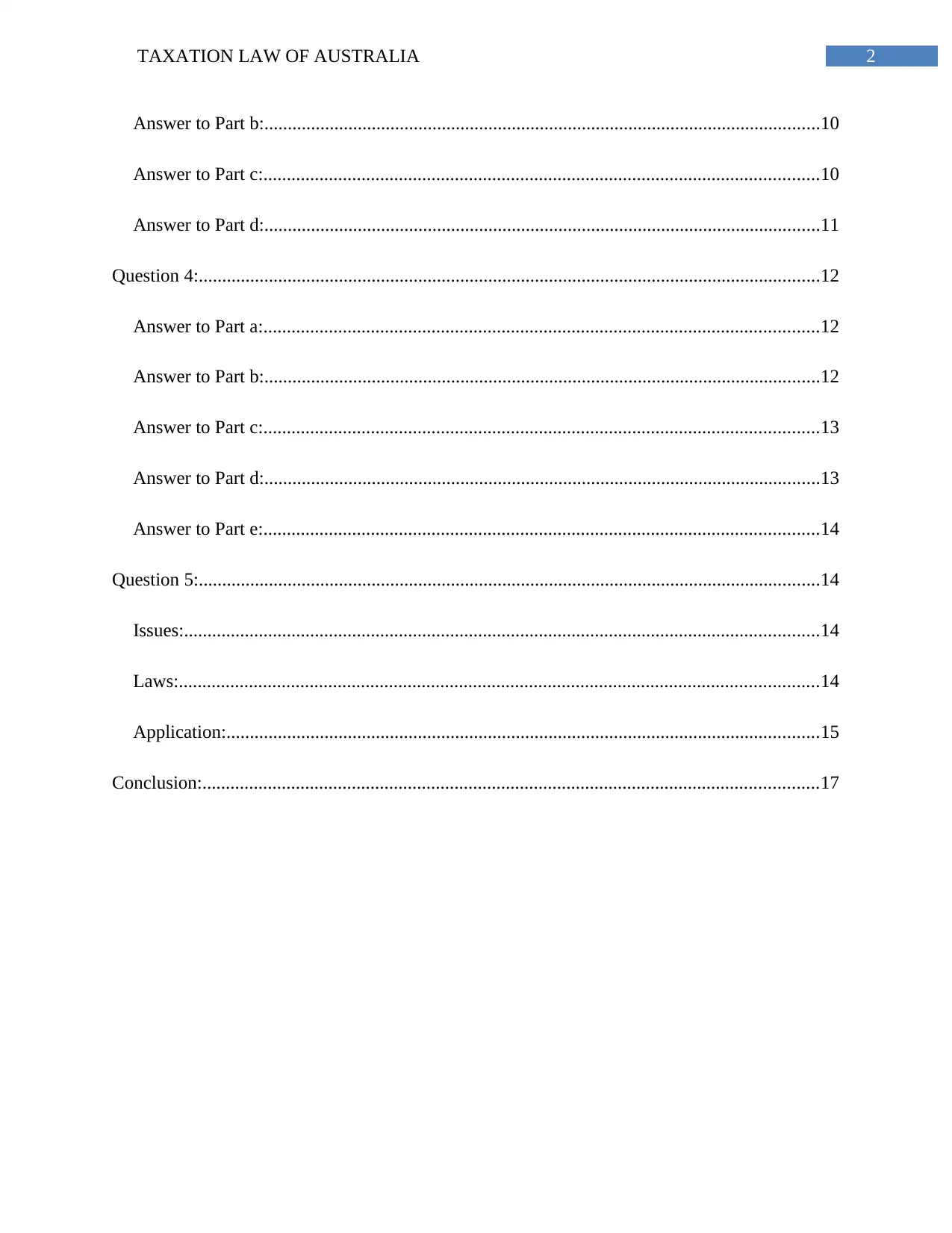
2TAXATION LAW OF AUSTRALIA
Answer to Part b:.......................................................................................................................10
Answer to Part c:.......................................................................................................................10
Answer to Part d:.......................................................................................................................11
Question 4:.....................................................................................................................................12
Answer to Part a:.......................................................................................................................12
Answer to Part b:.......................................................................................................................12
Answer to Part c:.......................................................................................................................13
Answer to Part d:.......................................................................................................................13
Answer to Part e:.......................................................................................................................14
Question 5:.....................................................................................................................................14
Issues:........................................................................................................................................14
Laws:.........................................................................................................................................14
Application:...............................................................................................................................15
Conclusion:....................................................................................................................................17
Answer to Part b:.......................................................................................................................10
Answer to Part c:.......................................................................................................................10
Answer to Part d:.......................................................................................................................11
Question 4:.....................................................................................................................................12
Answer to Part a:.......................................................................................................................12
Answer to Part b:.......................................................................................................................12
Answer to Part c:.......................................................................................................................13
Answer to Part d:.......................................................................................................................13
Answer to Part e:.......................................................................................................................14
Question 5:.....................................................................................................................................14
Issues:........................................................................................................................................14
Laws:.........................................................................................................................................14
Application:...............................................................................................................................15
Conclusion:....................................................................................................................................17
⊘ This is a preview!⊘
Do you want full access?
Subscribe today to unlock all pages.

Trusted by 1+ million students worldwide
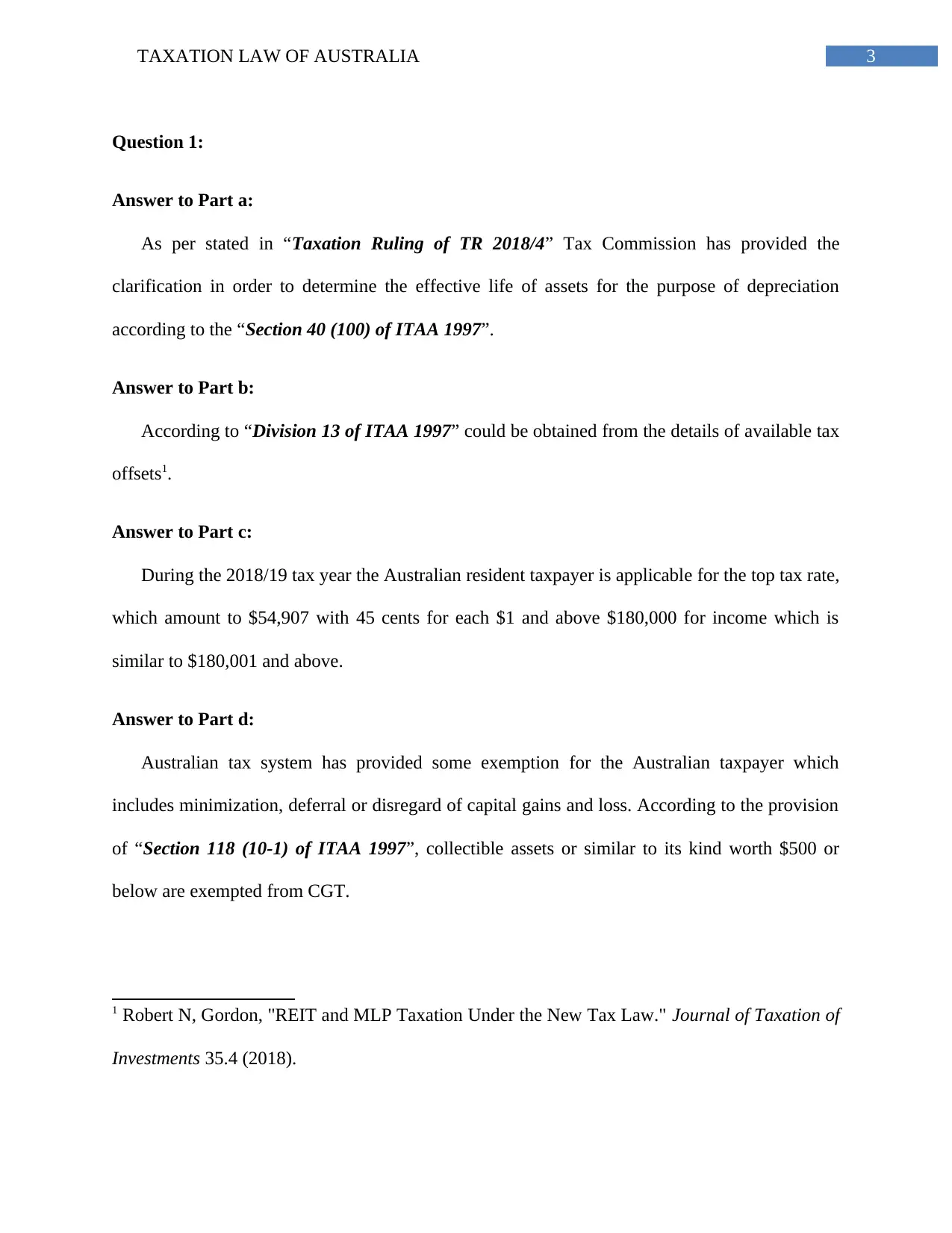
3TAXATION LAW OF AUSTRALIA
Question 1:
Answer to Part a:
As per stated in “Taxation Ruling of TR 2018/4” Tax Commission has provided the
clarification in order to determine the effective life of assets for the purpose of depreciation
according to the “Section 40 (100) of ITAA 1997”.
Answer to Part b:
According to “Division 13 of ITAA 1997” could be obtained from the details of available tax
offsets1.
Answer to Part c:
During the 2018/19 tax year the Australian resident taxpayer is applicable for the top tax rate,
which amount to $54,907 with 45 cents for each $1 and above $180,000 for income which is
similar to $180,001 and above.
Answer to Part d:
Australian tax system has provided some exemption for the Australian taxpayer which
includes minimization, deferral or disregard of capital gains and loss. According to the provision
of “Section 118 (10-1) of ITAA 1997”, collectible assets or similar to its kind worth $500 or
below are exempted from CGT.
1 Robert N, Gordon, "REIT and MLP Taxation Under the New Tax Law." Journal of Taxation of
Investments 35.4 (2018).
Question 1:
Answer to Part a:
As per stated in “Taxation Ruling of TR 2018/4” Tax Commission has provided the
clarification in order to determine the effective life of assets for the purpose of depreciation
according to the “Section 40 (100) of ITAA 1997”.
Answer to Part b:
According to “Division 13 of ITAA 1997” could be obtained from the details of available tax
offsets1.
Answer to Part c:
During the 2018/19 tax year the Australian resident taxpayer is applicable for the top tax rate,
which amount to $54,907 with 45 cents for each $1 and above $180,000 for income which is
similar to $180,001 and above.
Answer to Part d:
Australian tax system has provided some exemption for the Australian taxpayer which
includes minimization, deferral or disregard of capital gains and loss. According to the provision
of “Section 118 (10-1) of ITAA 1997”, collectible assets or similar to its kind worth $500 or
below are exempted from CGT.
1 Robert N, Gordon, "REIT and MLP Taxation Under the New Tax Law." Journal of Taxation of
Investments 35.4 (2018).
Paraphrase This Document
Need a fresh take? Get an instant paraphrase of this document with our AI Paraphraser
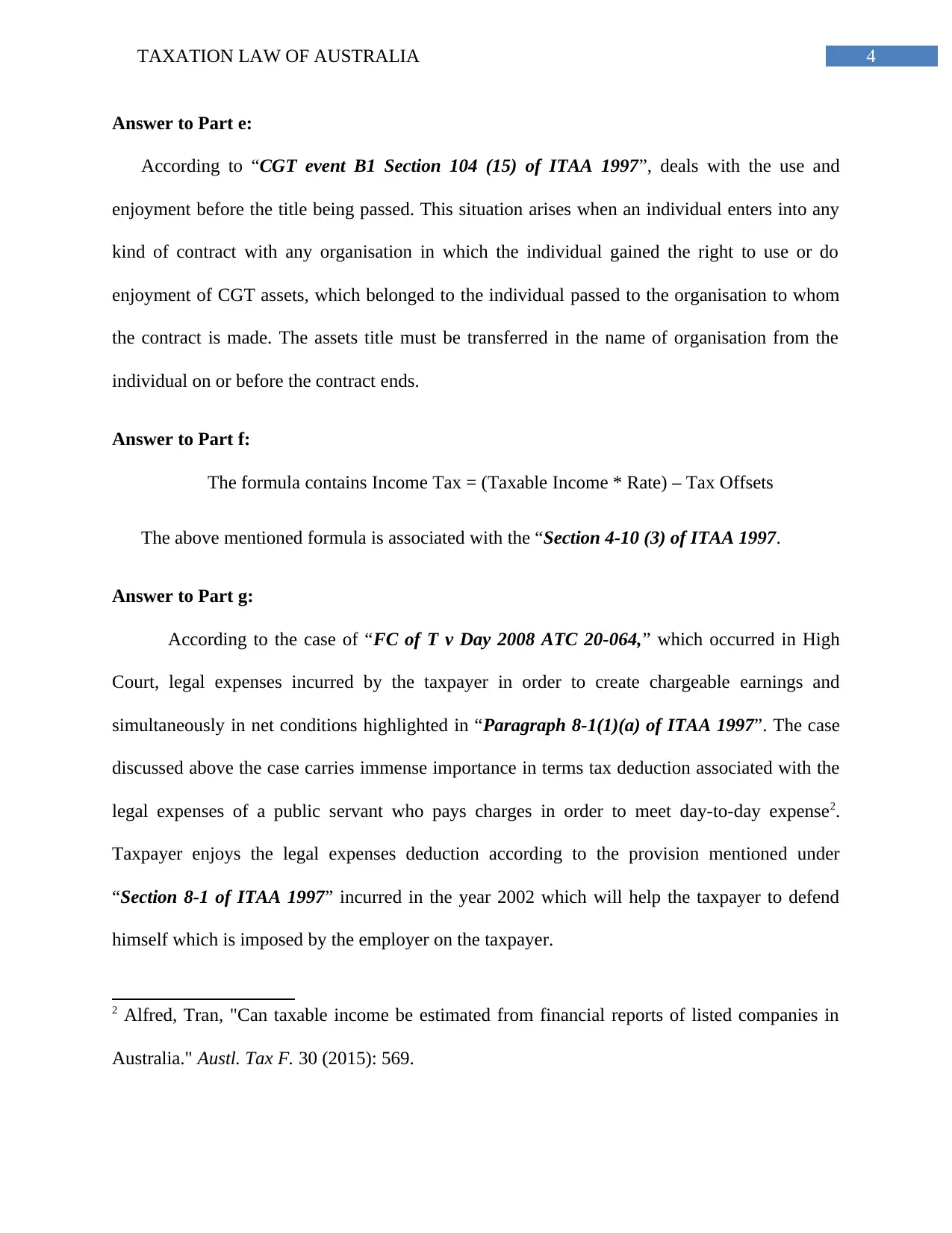
4TAXATION LAW OF AUSTRALIA
Answer to Part e:
According to “CGT event B1 Section 104 (15) of ITAA 1997”, deals with the use and
enjoyment before the title being passed. This situation arises when an individual enters into any
kind of contract with any organisation in which the individual gained the right to use or do
enjoyment of CGT assets, which belonged to the individual passed to the organisation to whom
the contract is made. The assets title must be transferred in the name of organisation from the
individual on or before the contract ends.
Answer to Part f:
The formula contains Income Tax = (Taxable Income * Rate) – Tax Offsets
The above mentioned formula is associated with the “Section 4-10 (3) of ITAA 1997.
Answer to Part g:
According to the case of “FC of T v Day 2008 ATC 20-064,” which occurred in High
Court, legal expenses incurred by the taxpayer in order to create chargeable earnings and
simultaneously in net conditions highlighted in “Paragraph 8-1(1)(a) of ITAA 1997”. The case
discussed above the case carries immense importance in terms tax deduction associated with the
legal expenses of a public servant who pays charges in order to meet day-to-day expense2.
Taxpayer enjoys the legal expenses deduction according to the provision mentioned under
“Section 8-1 of ITAA 1997” incurred in the year 2002 which will help the taxpayer to defend
himself which is imposed by the employer on the taxpayer.
2 Alfred, Tran, "Can taxable income be estimated from financial reports of listed companies in
Australia." Austl. Tax F. 30 (2015): 569.
Answer to Part e:
According to “CGT event B1 Section 104 (15) of ITAA 1997”, deals with the use and
enjoyment before the title being passed. This situation arises when an individual enters into any
kind of contract with any organisation in which the individual gained the right to use or do
enjoyment of CGT assets, which belonged to the individual passed to the organisation to whom
the contract is made. The assets title must be transferred in the name of organisation from the
individual on or before the contract ends.
Answer to Part f:
The formula contains Income Tax = (Taxable Income * Rate) – Tax Offsets
The above mentioned formula is associated with the “Section 4-10 (3) of ITAA 1997.
Answer to Part g:
According to the case of “FC of T v Day 2008 ATC 20-064,” which occurred in High
Court, legal expenses incurred by the taxpayer in order to create chargeable earnings and
simultaneously in net conditions highlighted in “Paragraph 8-1(1)(a) of ITAA 1997”. The case
discussed above the case carries immense importance in terms tax deduction associated with the
legal expenses of a public servant who pays charges in order to meet day-to-day expense2.
Taxpayer enjoys the legal expenses deduction according to the provision mentioned under
“Section 8-1 of ITAA 1997” incurred in the year 2002 which will help the taxpayer to defend
himself which is imposed by the employer on the taxpayer.
2 Alfred, Tran, "Can taxable income be estimated from financial reports of listed companies in
Australia." Austl. Tax F. 30 (2015): 569.
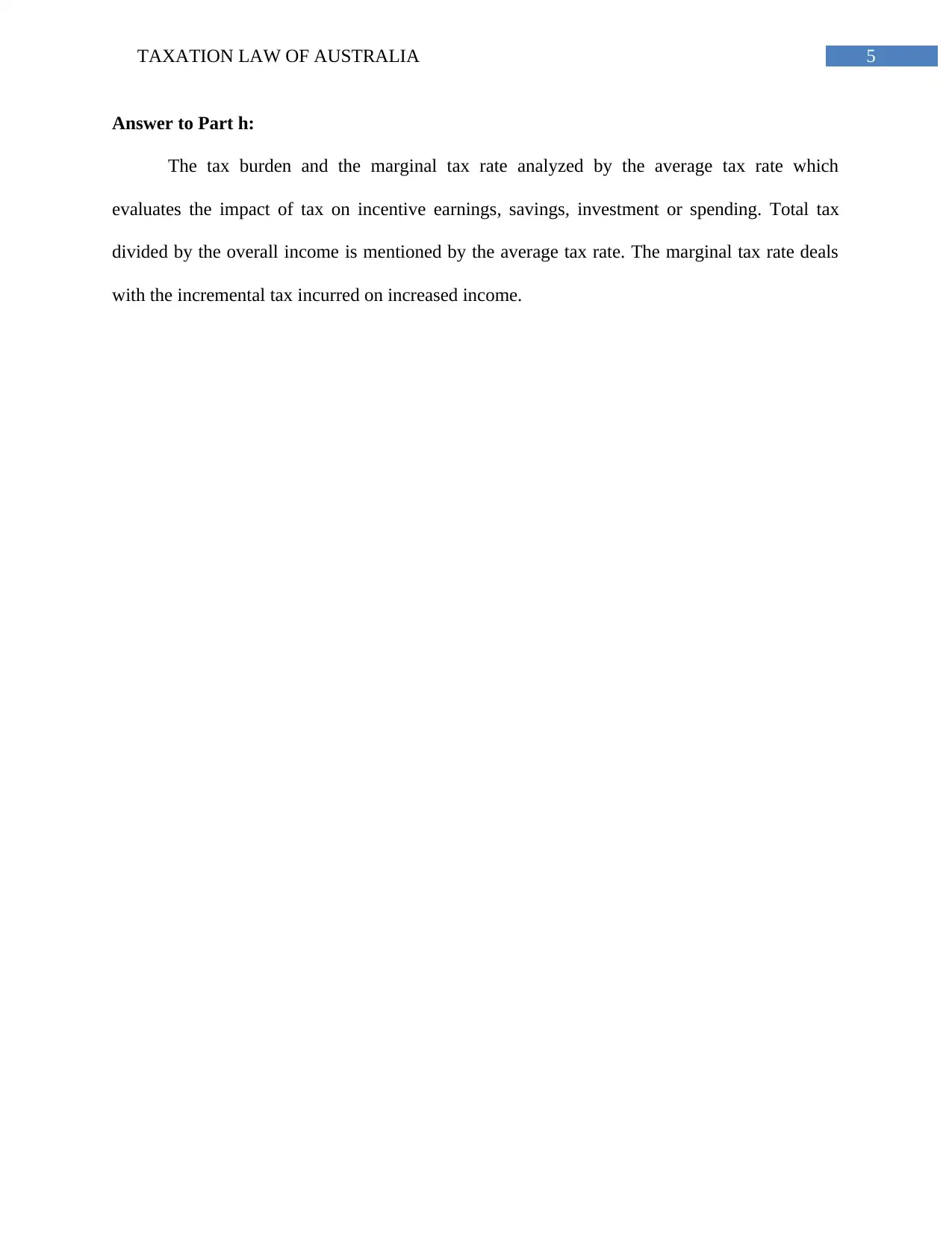
5TAXATION LAW OF AUSTRALIA
Answer to Part h:
The tax burden and the marginal tax rate analyzed by the average tax rate which
evaluates the impact of tax on incentive earnings, savings, investment or spending. Total tax
divided by the overall income is mentioned by the average tax rate. The marginal tax rate deals
with the incremental tax incurred on increased income.
Answer to Part h:
The tax burden and the marginal tax rate analyzed by the average tax rate which
evaluates the impact of tax on incentive earnings, savings, investment or spending. Total tax
divided by the overall income is mentioned by the average tax rate. The marginal tax rate deals
with the incremental tax incurred on increased income.
⊘ This is a preview!⊘
Do you want full access?
Subscribe today to unlock all pages.

Trusted by 1+ million students worldwide
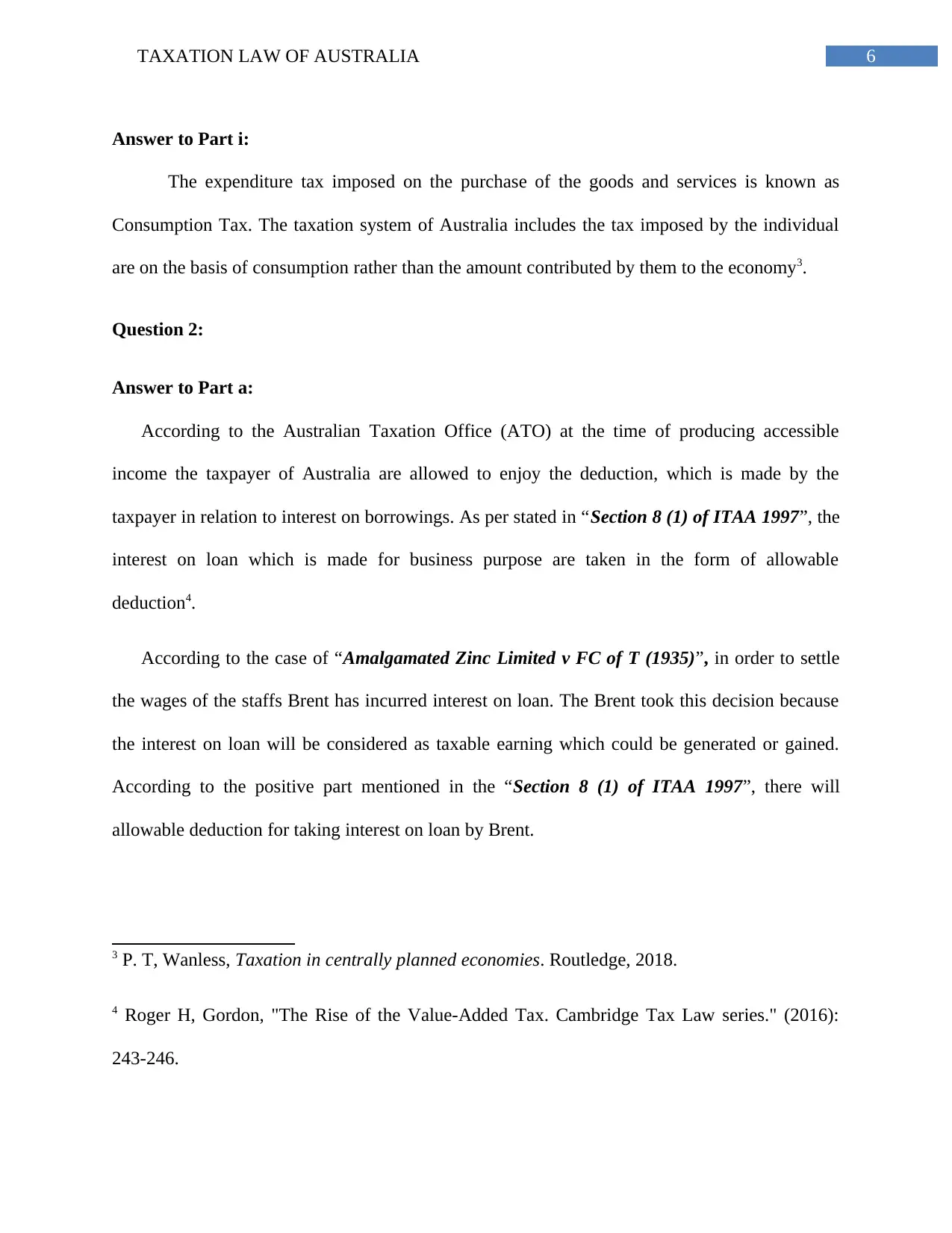
6TAXATION LAW OF AUSTRALIA
Answer to Part i:
The expenditure tax imposed on the purchase of the goods and services is known as
Consumption Tax. The taxation system of Australia includes the tax imposed by the individual
are on the basis of consumption rather than the amount contributed by them to the economy3.
Question 2:
Answer to Part a:
According to the Australian Taxation Office (ATO) at the time of producing accessible
income the taxpayer of Australia are allowed to enjoy the deduction, which is made by the
taxpayer in relation to interest on borrowings. As per stated in “Section 8 (1) of ITAA 1997”, the
interest on loan which is made for business purpose are taken in the form of allowable
deduction4.
According to the case of “Amalgamated Zinc Limited v FC of T (1935)”, in order to settle
the wages of the staffs Brent has incurred interest on loan. The Brent took this decision because
the interest on loan will be considered as taxable earning which could be generated or gained.
According to the positive part mentioned in the “Section 8 (1) of ITAA 1997”, there will
allowable deduction for taking interest on loan by Brent.
3 P. T, Wanless, Taxation in centrally planned economies. Routledge, 2018.
4 Roger H, Gordon, "The Rise of the Value-Added Tax. Cambridge Tax Law series." (2016):
243-246.
Answer to Part i:
The expenditure tax imposed on the purchase of the goods and services is known as
Consumption Tax. The taxation system of Australia includes the tax imposed by the individual
are on the basis of consumption rather than the amount contributed by them to the economy3.
Question 2:
Answer to Part a:
According to the Australian Taxation Office (ATO) at the time of producing accessible
income the taxpayer of Australia are allowed to enjoy the deduction, which is made by the
taxpayer in relation to interest on borrowings. As per stated in “Section 8 (1) of ITAA 1997”, the
interest on loan which is made for business purpose are taken in the form of allowable
deduction4.
According to the case of “Amalgamated Zinc Limited v FC of T (1935)”, in order to settle
the wages of the staffs Brent has incurred interest on loan. The Brent took this decision because
the interest on loan will be considered as taxable earning which could be generated or gained.
According to the positive part mentioned in the “Section 8 (1) of ITAA 1997”, there will
allowable deduction for taking interest on loan by Brent.
3 P. T, Wanless, Taxation in centrally planned economies. Routledge, 2018.
4 Roger H, Gordon, "The Rise of the Value-Added Tax. Cambridge Tax Law series." (2016):
243-246.
Paraphrase This Document
Need a fresh take? Get an instant paraphrase of this document with our AI Paraphraser
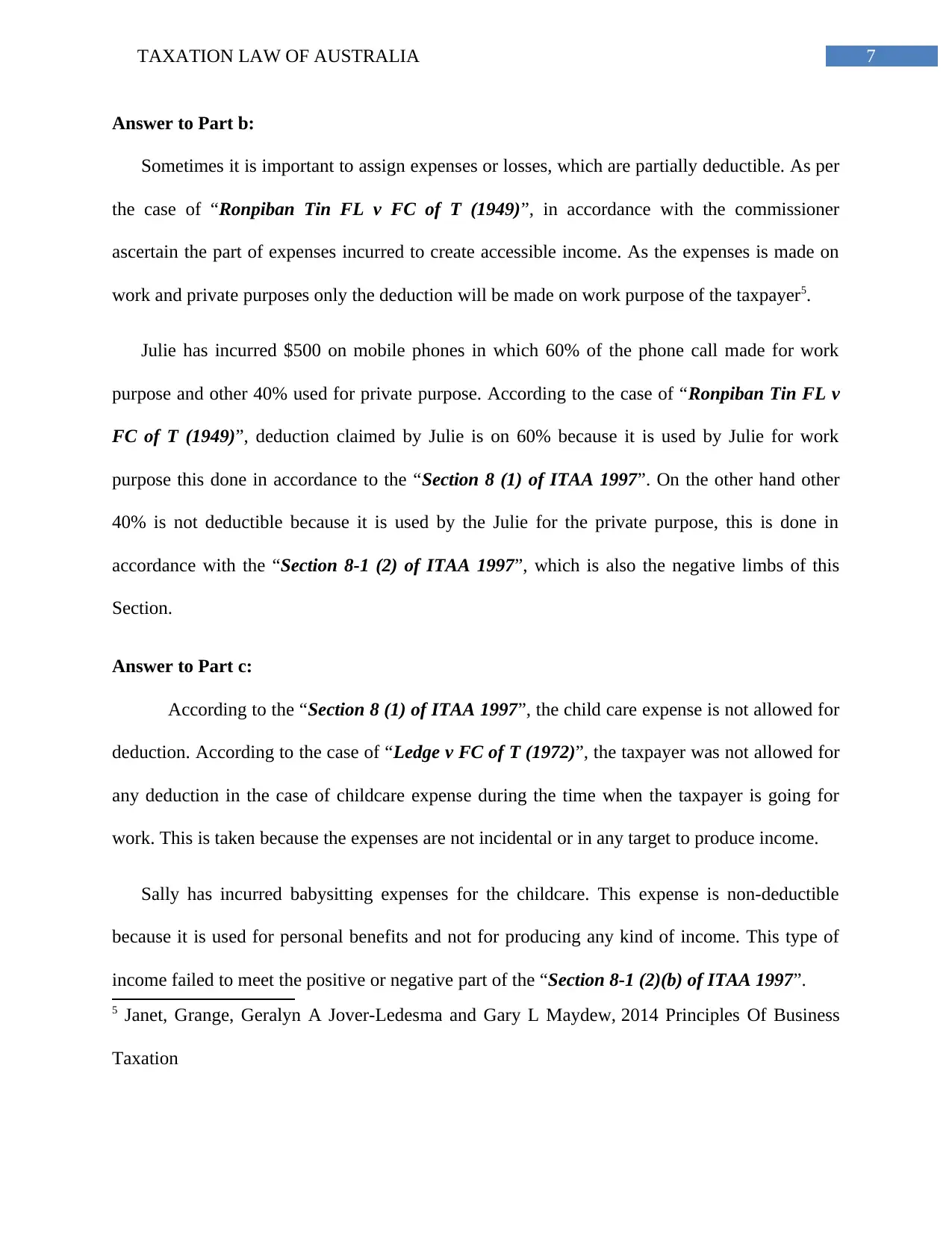
7TAXATION LAW OF AUSTRALIA
Answer to Part b:
Sometimes it is important to assign expenses or losses, which are partially deductible. As per
the case of “Ronpiban Tin FL v FC of T (1949)”, in accordance with the commissioner
ascertain the part of expenses incurred to create accessible income. As the expenses is made on
work and private purposes only the deduction will be made on work purpose of the taxpayer5.
Julie has incurred $500 on mobile phones in which 60% of the phone call made for work
purpose and other 40% used for private purpose. According to the case of “Ronpiban Tin FL v
FC of T (1949)”, deduction claimed by Julie is on 60% because it is used by Julie for work
purpose this done in accordance to the “Section 8 (1) of ITAA 1997”. On the other hand other
40% is not deductible because it is used by the Julie for the private purpose, this is done in
accordance with the “Section 8-1 (2) of ITAA 1997”, which is also the negative limbs of this
Section.
Answer to Part c:
According to the “Section 8 (1) of ITAA 1997”, the child care expense is not allowed for
deduction. According to the case of “Ledge v FC of T (1972)”, the taxpayer was not allowed for
any deduction in the case of childcare expense during the time when the taxpayer is going for
work. This is taken because the expenses are not incidental or in any target to produce income.
Sally has incurred babysitting expenses for the childcare. This expense is non-deductible
because it is used for personal benefits and not for producing any kind of income. This type of
income failed to meet the positive or negative part of the “Section 8-1 (2)(b) of ITAA 1997”.
5 Janet, Grange, Geralyn A Jover-Ledesma and Gary L Maydew, 2014 Principles Of Business
Taxation
Answer to Part b:
Sometimes it is important to assign expenses or losses, which are partially deductible. As per
the case of “Ronpiban Tin FL v FC of T (1949)”, in accordance with the commissioner
ascertain the part of expenses incurred to create accessible income. As the expenses is made on
work and private purposes only the deduction will be made on work purpose of the taxpayer5.
Julie has incurred $500 on mobile phones in which 60% of the phone call made for work
purpose and other 40% used for private purpose. According to the case of “Ronpiban Tin FL v
FC of T (1949)”, deduction claimed by Julie is on 60% because it is used by Julie for work
purpose this done in accordance to the “Section 8 (1) of ITAA 1997”. On the other hand other
40% is not deductible because it is used by the Julie for the private purpose, this is done in
accordance with the “Section 8-1 (2) of ITAA 1997”, which is also the negative limbs of this
Section.
Answer to Part c:
According to the “Section 8 (1) of ITAA 1997”, the child care expense is not allowed for
deduction. According to the case of “Ledge v FC of T (1972)”, the taxpayer was not allowed for
any deduction in the case of childcare expense during the time when the taxpayer is going for
work. This is taken because the expenses are not incidental or in any target to produce income.
Sally has incurred babysitting expenses for the childcare. This expense is non-deductible
because it is used for personal benefits and not for producing any kind of income. This type of
income failed to meet the positive or negative part of the “Section 8-1 (2)(b) of ITAA 1997”.
5 Janet, Grange, Geralyn A Jover-Ledesma and Gary L Maydew, 2014 Principles Of Business
Taxation
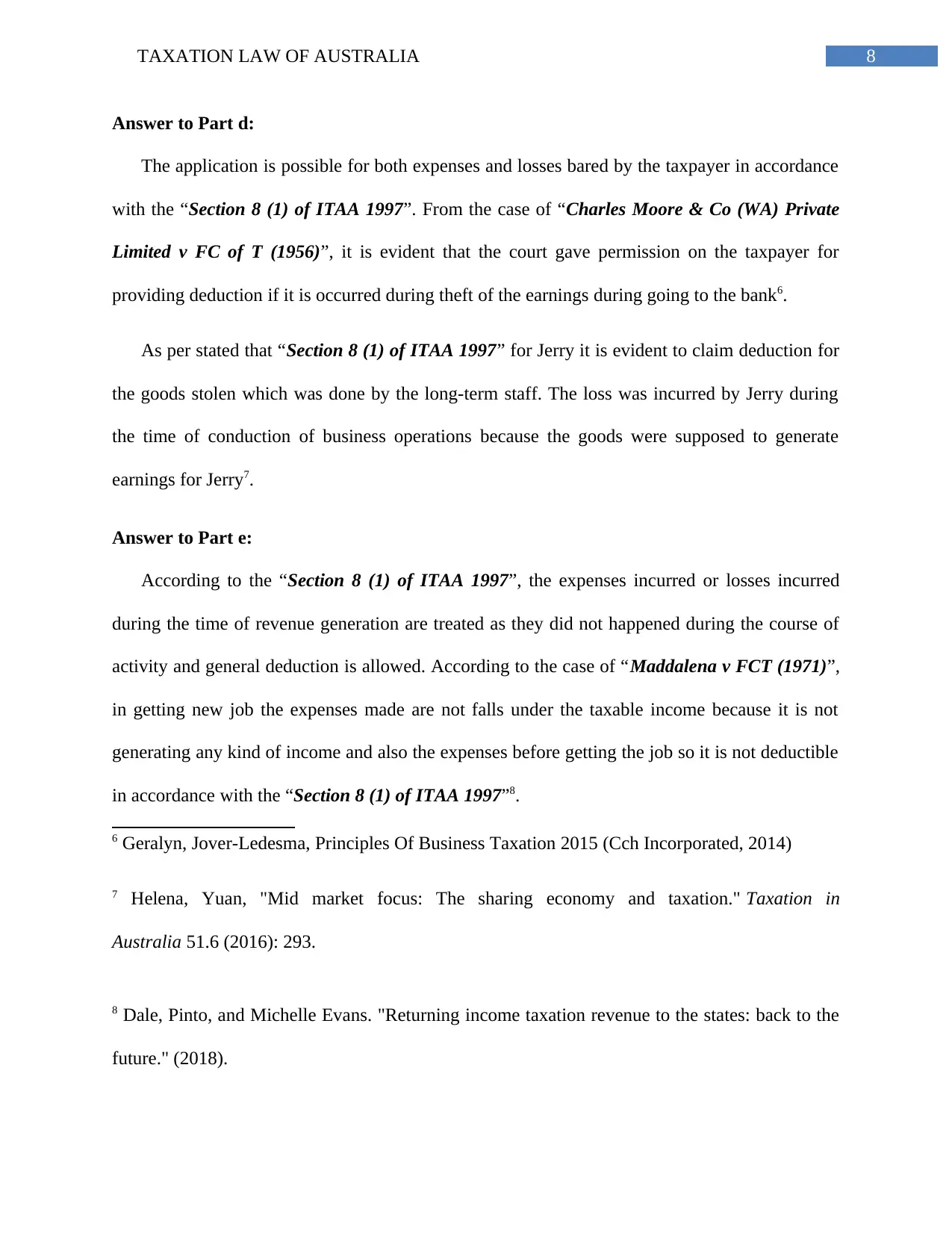
8TAXATION LAW OF AUSTRALIA
Answer to Part d:
The application is possible for both expenses and losses bared by the taxpayer in accordance
with the “Section 8 (1) of ITAA 1997”. From the case of “Charles Moore & Co (WA) Private
Limited v FC of T (1956)”, it is evident that the court gave permission on the taxpayer for
providing deduction if it is occurred during theft of the earnings during going to the bank6.
As per stated that “Section 8 (1) of ITAA 1997” for Jerry it is evident to claim deduction for
the goods stolen which was done by the long-term staff. The loss was incurred by Jerry during
the time of conduction of business operations because the goods were supposed to generate
earnings for Jerry7.
Answer to Part e:
According to the “Section 8 (1) of ITAA 1997”, the expenses incurred or losses incurred
during the time of revenue generation are treated as they did not happened during the course of
activity and general deduction is allowed. According to the case of “Maddalena v FCT (1971)”,
in getting new job the expenses made are not falls under the taxable income because it is not
generating any kind of income and also the expenses before getting the job so it is not deductible
in accordance with the “Section 8 (1) of ITAA 1997”8.
6 Geralyn, Jover-Ledesma, Principles Of Business Taxation 2015 (Cch Incorporated, 2014)
7 Helena, Yuan, "Mid market focus: The sharing economy and taxation." Taxation in
Australia 51.6 (2016): 293.
8 Dale, Pinto, and Michelle Evans. "Returning income taxation revenue to the states: back to the
future." (2018).
Answer to Part d:
The application is possible for both expenses and losses bared by the taxpayer in accordance
with the “Section 8 (1) of ITAA 1997”. From the case of “Charles Moore & Co (WA) Private
Limited v FC of T (1956)”, it is evident that the court gave permission on the taxpayer for
providing deduction if it is occurred during theft of the earnings during going to the bank6.
As per stated that “Section 8 (1) of ITAA 1997” for Jerry it is evident to claim deduction for
the goods stolen which was done by the long-term staff. The loss was incurred by Jerry during
the time of conduction of business operations because the goods were supposed to generate
earnings for Jerry7.
Answer to Part e:
According to the “Section 8 (1) of ITAA 1997”, the expenses incurred or losses incurred
during the time of revenue generation are treated as they did not happened during the course of
activity and general deduction is allowed. According to the case of “Maddalena v FCT (1971)”,
in getting new job the expenses made are not falls under the taxable income because it is not
generating any kind of income and also the expenses before getting the job so it is not deductible
in accordance with the “Section 8 (1) of ITAA 1997”8.
6 Geralyn, Jover-Ledesma, Principles Of Business Taxation 2015 (Cch Incorporated, 2014)
7 Helena, Yuan, "Mid market focus: The sharing economy and taxation." Taxation in
Australia 51.6 (2016): 293.
8 Dale, Pinto, and Michelle Evans. "Returning income taxation revenue to the states: back to the
future." (2018).
⊘ This is a preview!⊘
Do you want full access?
Subscribe today to unlock all pages.

Trusted by 1+ million students worldwide
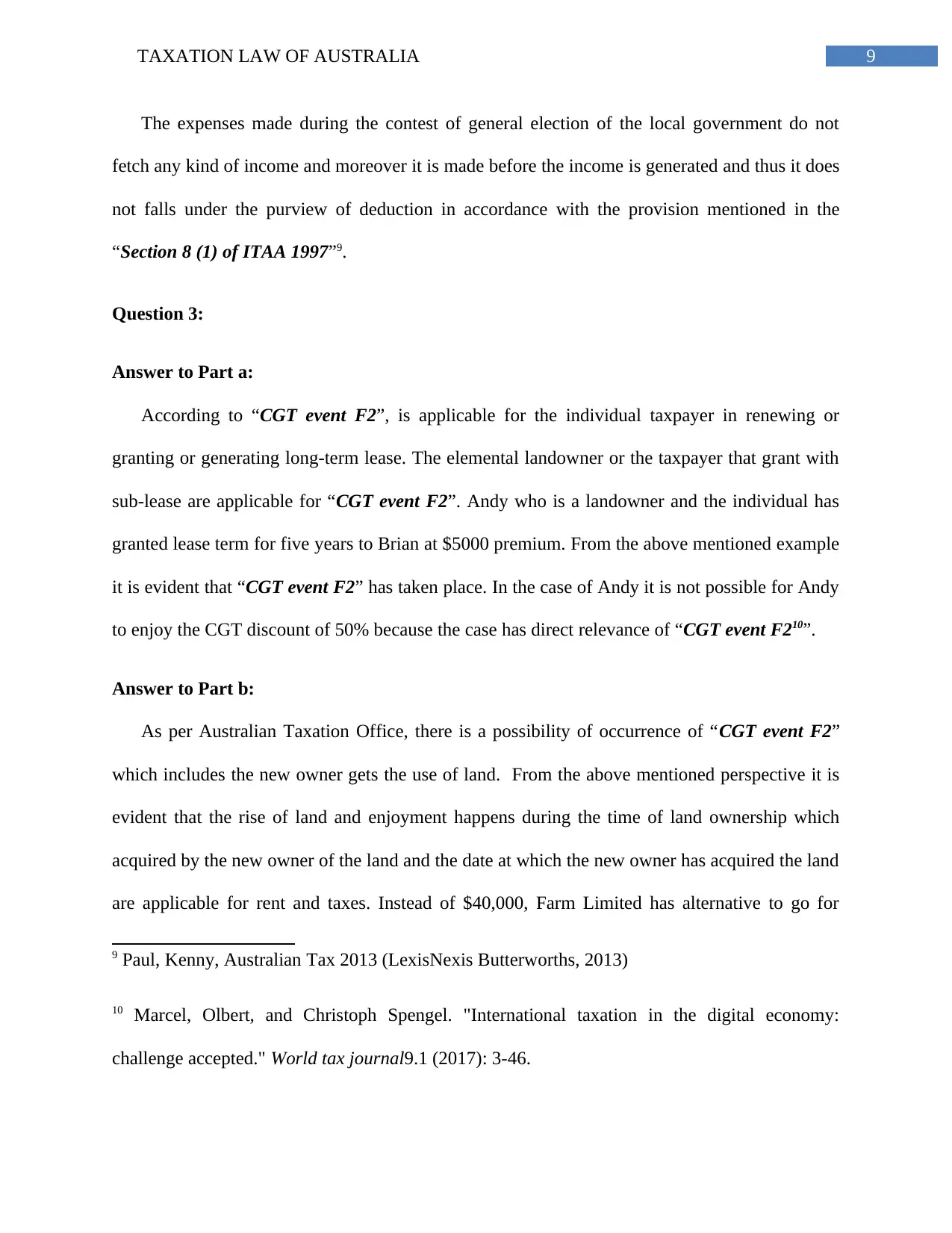
9TAXATION LAW OF AUSTRALIA
The expenses made during the contest of general election of the local government do not
fetch any kind of income and moreover it is made before the income is generated and thus it does
not falls under the purview of deduction in accordance with the provision mentioned in the
“Section 8 (1) of ITAA 1997”9.
Question 3:
Answer to Part a:
According to “CGT event F2”, is applicable for the individual taxpayer in renewing or
granting or generating long-term lease. The elemental landowner or the taxpayer that grant with
sub-lease are applicable for “CGT event F2”. Andy who is a landowner and the individual has
granted lease term for five years to Brian at $5000 premium. From the above mentioned example
it is evident that “CGT event F2” has taken place. In the case of Andy it is not possible for Andy
to enjoy the CGT discount of 50% because the case has direct relevance of “CGT event F210”.
Answer to Part b:
As per Australian Taxation Office, there is a possibility of occurrence of “CGT event F2”
which includes the new owner gets the use of land. From the above mentioned perspective it is
evident that the rise of land and enjoyment happens during the time of land ownership which
acquired by the new owner of the land and the date at which the new owner has acquired the land
are applicable for rent and taxes. Instead of $40,000, Farm Limited has alternative to go for
9 Paul, Kenny, Australian Tax 2013 (LexisNexis Butterworths, 2013)
10 Marcel, Olbert, and Christoph Spengel. "International taxation in the digital economy:
challenge accepted." World tax journal9.1 (2017): 3-46.
The expenses made during the contest of general election of the local government do not
fetch any kind of income and moreover it is made before the income is generated and thus it does
not falls under the purview of deduction in accordance with the provision mentioned in the
“Section 8 (1) of ITAA 1997”9.
Question 3:
Answer to Part a:
According to “CGT event F2”, is applicable for the individual taxpayer in renewing or
granting or generating long-term lease. The elemental landowner or the taxpayer that grant with
sub-lease are applicable for “CGT event F2”. Andy who is a landowner and the individual has
granted lease term for five years to Brian at $5000 premium. From the above mentioned example
it is evident that “CGT event F2” has taken place. In the case of Andy it is not possible for Andy
to enjoy the CGT discount of 50% because the case has direct relevance of “CGT event F210”.
Answer to Part b:
As per Australian Taxation Office, there is a possibility of occurrence of “CGT event F2”
which includes the new owner gets the use of land. From the above mentioned perspective it is
evident that the rise of land and enjoyment happens during the time of land ownership which
acquired by the new owner of the land and the date at which the new owner has acquired the land
are applicable for rent and taxes. Instead of $40,000, Farm Limited has alternative to go for
9 Paul, Kenny, Australian Tax 2013 (LexisNexis Butterworths, 2013)
10 Marcel, Olbert, and Christoph Spengel. "International taxation in the digital economy:
challenge accepted." World tax journal9.1 (2017): 3-46.
Paraphrase This Document
Need a fresh take? Get an instant paraphrase of this document with our AI Paraphraser
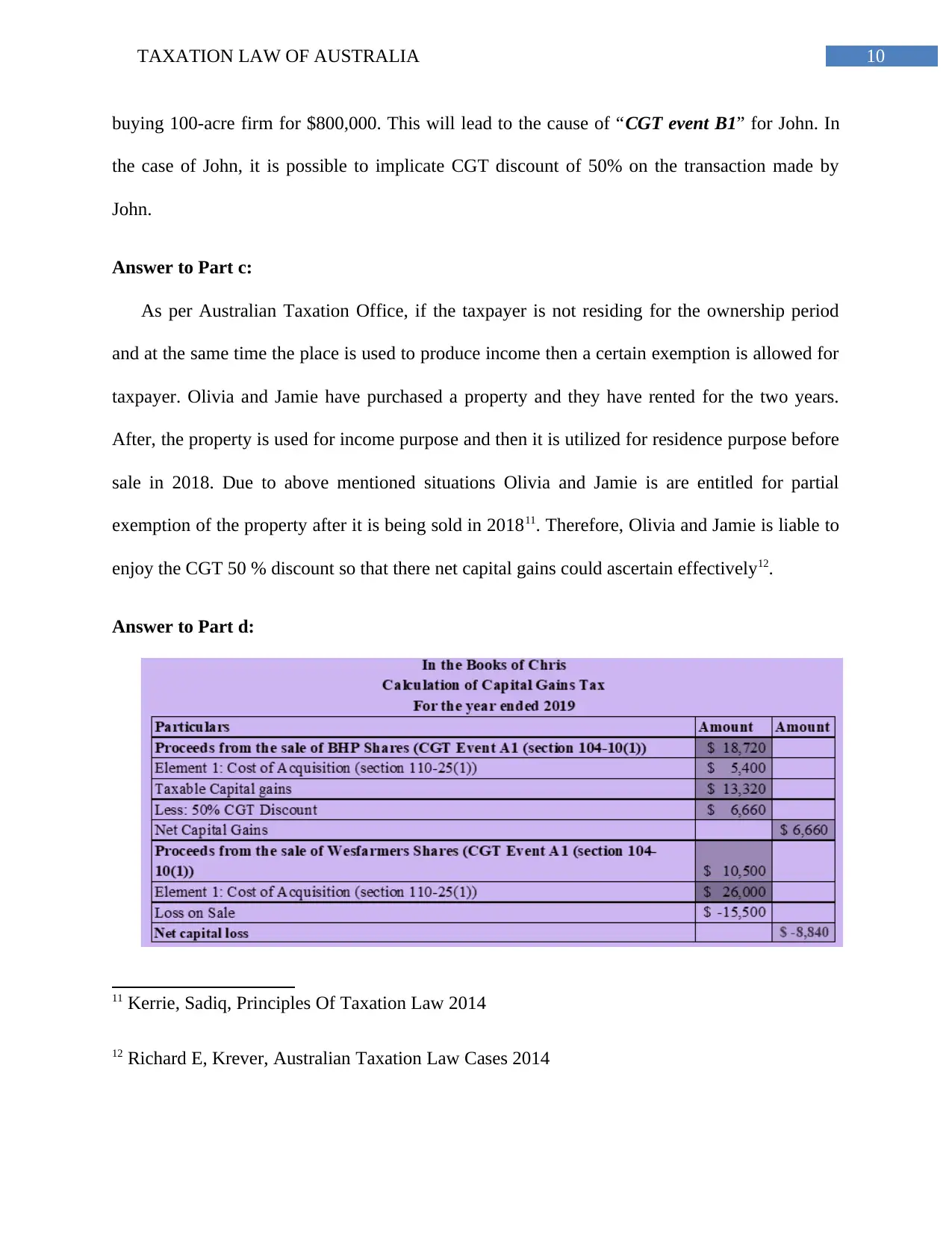
10TAXATION LAW OF AUSTRALIA
buying 100-acre firm for $800,000. This will lead to the cause of “CGT event B1” for John. In
the case of John, it is possible to implicate CGT discount of 50% on the transaction made by
John.
Answer to Part c:
As per Australian Taxation Office, if the taxpayer is not residing for the ownership period
and at the same time the place is used to produce income then a certain exemption is allowed for
taxpayer. Olivia and Jamie have purchased a property and they have rented for the two years.
After, the property is used for income purpose and then it is utilized for residence purpose before
sale in 2018. Due to above mentioned situations Olivia and Jamie is are entitled for partial
exemption of the property after it is being sold in 201811. Therefore, Olivia and Jamie is liable to
enjoy the CGT 50 % discount so that there net capital gains could ascertain effectively12.
Answer to Part d:
11 Kerrie, Sadiq, Principles Of Taxation Law 2014
12 Richard E, Krever, Australian Taxation Law Cases 2014
buying 100-acre firm for $800,000. This will lead to the cause of “CGT event B1” for John. In
the case of John, it is possible to implicate CGT discount of 50% on the transaction made by
John.
Answer to Part c:
As per Australian Taxation Office, if the taxpayer is not residing for the ownership period
and at the same time the place is used to produce income then a certain exemption is allowed for
taxpayer. Olivia and Jamie have purchased a property and they have rented for the two years.
After, the property is used for income purpose and then it is utilized for residence purpose before
sale in 2018. Due to above mentioned situations Olivia and Jamie is are entitled for partial
exemption of the property after it is being sold in 201811. Therefore, Olivia and Jamie is liable to
enjoy the CGT 50 % discount so that there net capital gains could ascertain effectively12.
Answer to Part d:
11 Kerrie, Sadiq, Principles Of Taxation Law 2014
12 Richard E, Krever, Australian Taxation Law Cases 2014
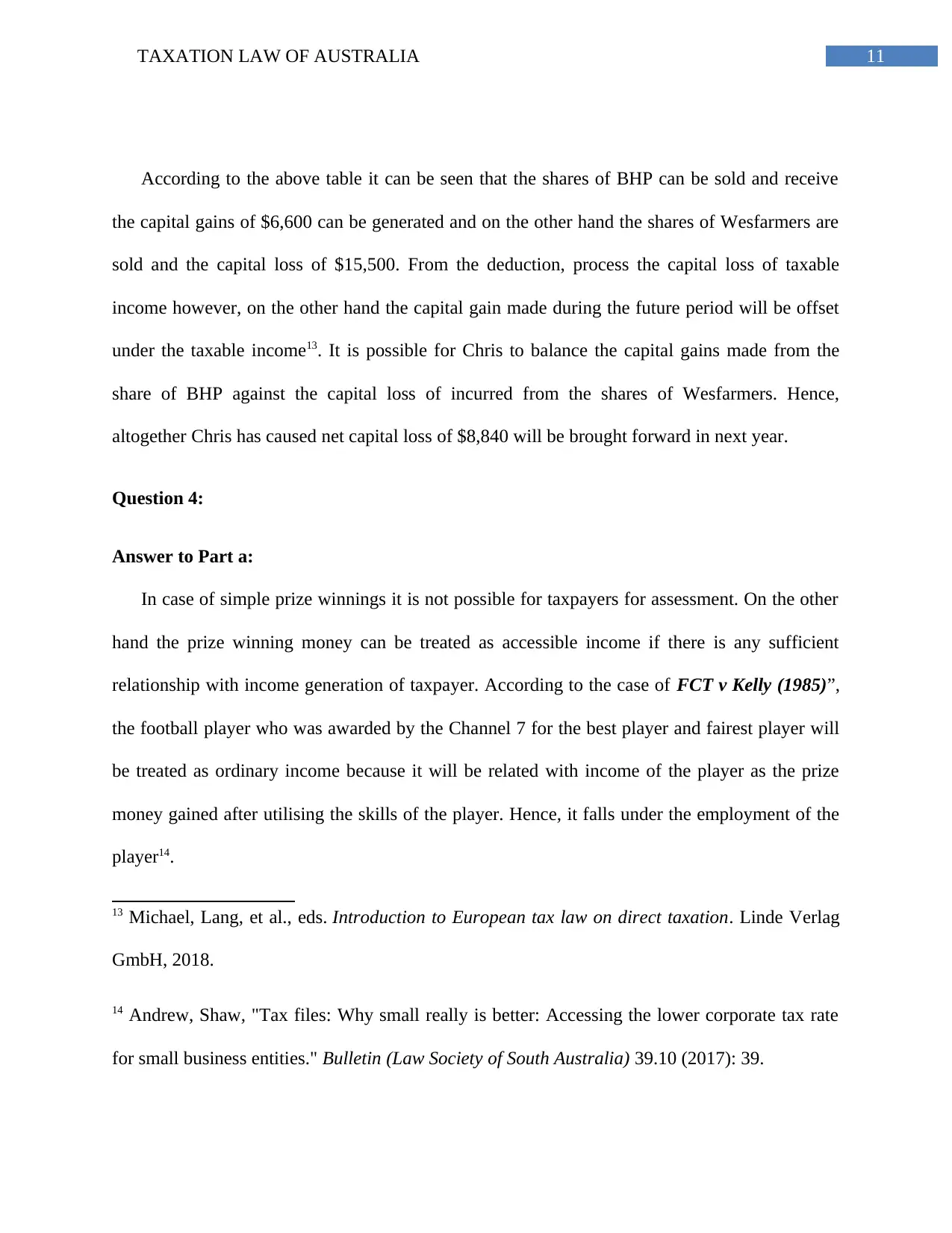
11TAXATION LAW OF AUSTRALIA
According to the above table it can be seen that the shares of BHP can be sold and receive
the capital gains of $6,600 can be generated and on the other hand the shares of Wesfarmers are
sold and the capital loss of $15,500. From the deduction, process the capital loss of taxable
income however, on the other hand the capital gain made during the future period will be offset
under the taxable income13. It is possible for Chris to balance the capital gains made from the
share of BHP against the capital loss of incurred from the shares of Wesfarmers. Hence,
altogether Chris has caused net capital loss of $8,840 will be brought forward in next year.
Question 4:
Answer to Part a:
In case of simple prize winnings it is not possible for taxpayers for assessment. On the other
hand the prize winning money can be treated as accessible income if there is any sufficient
relationship with income generation of taxpayer. According to the case of FCT v Kelly (1985)”,
the football player who was awarded by the Channel 7 for the best player and fairest player will
be treated as ordinary income because it will be related with income of the player as the prize
money gained after utilising the skills of the player. Hence, it falls under the employment of the
player14.
13 Michael, Lang, et al., eds. Introduction to European tax law on direct taxation. Linde Verlag
GmbH, 2018.
14 Andrew, Shaw, "Tax files: Why small really is better: Accessing the lower corporate tax rate
for small business entities." Bulletin (Law Society of South Australia) 39.10 (2017): 39.
According to the above table it can be seen that the shares of BHP can be sold and receive
the capital gains of $6,600 can be generated and on the other hand the shares of Wesfarmers are
sold and the capital loss of $15,500. From the deduction, process the capital loss of taxable
income however, on the other hand the capital gain made during the future period will be offset
under the taxable income13. It is possible for Chris to balance the capital gains made from the
share of BHP against the capital loss of incurred from the shares of Wesfarmers. Hence,
altogether Chris has caused net capital loss of $8,840 will be brought forward in next year.
Question 4:
Answer to Part a:
In case of simple prize winnings it is not possible for taxpayers for assessment. On the other
hand the prize winning money can be treated as accessible income if there is any sufficient
relationship with income generation of taxpayer. According to the case of FCT v Kelly (1985)”,
the football player who was awarded by the Channel 7 for the best player and fairest player will
be treated as ordinary income because it will be related with income of the player as the prize
money gained after utilising the skills of the player. Hence, it falls under the employment of the
player14.
13 Michael, Lang, et al., eds. Introduction to European tax law on direct taxation. Linde Verlag
GmbH, 2018.
14 Andrew, Shaw, "Tax files: Why small really is better: Accessing the lower corporate tax rate
for small business entities." Bulletin (Law Society of South Australia) 39.10 (2017): 39.
⊘ This is a preview!⊘
Do you want full access?
Subscribe today to unlock all pages.

Trusted by 1+ million students worldwide
1 out of 19
Related Documents
Your All-in-One AI-Powered Toolkit for Academic Success.
+13062052269
info@desklib.com
Available 24*7 on WhatsApp / Email
![[object Object]](/_next/static/media/star-bottom.7253800d.svg)
Unlock your academic potential
Copyright © 2020–2025 A2Z Services. All Rights Reserved. Developed and managed by ZUCOL.





